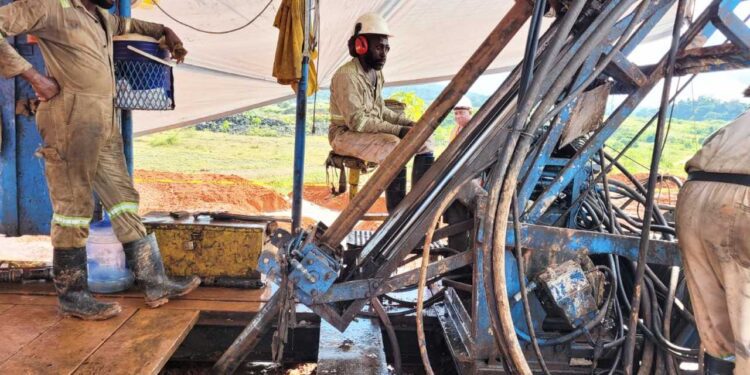Commences Phase 2 with Two Drills and Continues to Report Strong Results
Omai Gold Mines Corp. (TSXV: OMG) has completed the initial 5,000m drilling programme on its Omai project in Guyana has been completed and a Phase 2 exploration programme is underway with two drills.
A total of seventeen diamond drill holes totalling 7,323m have been completed to date this year.
Highlights from recent drilling include: 19 metres (m) grading 6.92 grams per tonne gold (g/t Au), 16 m of 2.2 gpt Au, 1.5 m of 56.0 gpt Au and 12.0 m of 2.12 gpt.
Twelve of the completed holes tested beneath the past producing Wenot pit, all of which confirmed that the Wenot Shear Corridor and the associated gold mineralization, extend to depths of at least 100 to 250m below the past-producing pit.
The Wenot pit produced approximately 1.4 million ounces of gold at an average grade of 1.5 gpt Au between 1993 and 20021.
Mineralisation is hosted within the 200m to 350m wide shear corridor that extends the full 1.7 km length of the pit and along strike. The pit was mined to a maximum depth of 200m.
Results from the current drilling plus the sampling of the 2012 drill core preserved by the Guyana Geology & Mines Commission (GGMC) are being integrated with data from 39 historic Golden Star and Cambior holes that extend below the Wenot pit bottom or test the Wenot shear along its strike extensions.
A wealth of pre-production and production geological, structural and grade data has greatly assisted in the modelling of the structurally controlled gold mineralisation and grade trends. With the combined datasets, the company is working towards an initial NI 43-101 resource estimate for Wenot.
With the addition of a second drill in July, one short hole tested a geophysical feature southeast of the Fennell pit, intersecting only sheared volcanics. Four holes were completed to test a couple of known gold occurrences at Gilt Creek and Snake Pond, west of the Fennell pit, interpreted to be related to apophyses or fingers of the Omai stock intruding into the adjacent host volcanics.
Quartz veining and minor sulphidisation were encountered in holes ODD-016 and ODD-017, but no significant gold values were returned, notwithstanding the proximity to impressive near surface historic gold intersections including 21 m grading 6.9 gpt Au and 9 m of 2.7 gpt gold.
Trenching using the on-site excavator was initiated in this area in August and subsequent mapping of quartz veining in the saprolite confirmed a different orientation than previous work had assumed and may relate to splays off of the Wenot shear. These targets will be re-assessed for follow up work.
“The potential to build substantial near-term gold resources at Omai is undeniable. Rarely can you find a brownfields project like this, that produced an average of 300,000 ounces of gold per year, encumbered over its lifespan by a sub-$400 per ounce gold price environment, which has not seen significant subsequent exploration,” Interim CEO, Elaine Ellingham, said.
“An early corporate decision was made in 2003 to shut down Omai and relocate key equipment to Rosebel, considered a higher-priority development project at the time. Thus, Omai emerges as a unique opportunity to create significant value since potential extensions to mineralisation at depth and along strike were not even considered, nor were a number of compelling exploration targets.”
“In a short time period, we have built an impressive technical team of seasoned geologists with international gold experience, combined with technical expertise in senior management and on the Board, well equipped to execute on focused strategies to create significant shareholder value as we unlock the potential of this unique Omai gold project.”
For further information please visit: https://www.omaigoldmines.com/












